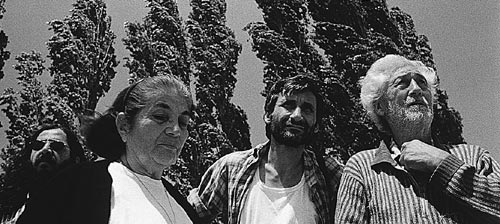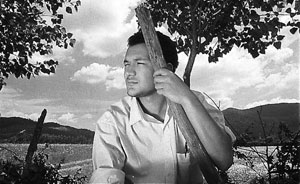Small Town Trilogy: Returning to the Small Town
 Clouds of May
Clouds of May
by Seray Genç /
In a snowy winter day, the children playing on the snow-white road, sliding, decide to play a game to the village’s loony when they see him coming. Without thinking that they are doing something bad, they just laugh at the guy when he slips and falls. First he laughs too with the kids. But the smile on his face soon fades in to another expression, becoming more and more apprehensive and pathetic. The multiple expressions of this face and the kids’ plays over the weak that they feel power over lead the film from the very first scene.
Muzaffer Özdemir, whom we meet, may be by coincidence (thanks to the improvising nature of Nuri Bilge Ceylan’s filmmaking), at the first yet astonishing scene of The Small Town, becomes a reflection of Nuri Bilge Ceylan in his later films, Clouds of May and Distant after The Small Town. Till the director’s last film The Climates in which the director acts also. In Nuri Bilge Ceylan’s films, faces, expressions on the faces and postures acquire a meaning within the wholeness of the film. Human faces and details from the faces, nature and details from the nature enlivens from photographs in his films. Considering Cocoon, The Small Town and Clouds of May, the main faces (characters) in all films are the director’s mother Fatma Ceylan, his father M. Emin Ceylan, Mehmet Emin Toprak and Muzaffer Özdemir. People from his family or his close friends form both the distinguishing side of Nuri Bilge Ceylan cinema and also the realistic nature of his filmmaking. The things that bring about realism though are not only the documentary screening of the small town, the real people living in that town or even his own parents’ acting in the film, but the ad-libbing presentation of life itself, making the spectator feel that what they see is what they see, i.e. the reality. His parents who most of the time play their own lives, and can not reject to their son’s wishes or resist to his convincing techniques, find themselves acting in the film eventually become an important and hearth warming part of the Nuri Bilge Ceylan cinema starting with the Cocoon. We don’t know whether one of the Nuri Bilge Ceylan’s convincing techniques for his parents, like was the case in Clouds of May, is to complain that the well-known Uncle Pire from the neighboring village demanded money for acting. But we know in Clouds of May that the real reason is the director in the film (Muzaffer Özdemir) actually does not want Uncle Pire to act in his film. That’s why, he does not want to get in a long conversation with the old lonely Uncle Pire, who lost his wife and goes back to try to convince his own father to act in the film following an unavoidable test shooting with Uncle Pire.
The black and white, 18-minute short film, the Cocoon as its name implies is the first manifestation of the director’s lust for filmmaking. This film emerges from the inner conflicts of the director in his desire for making a film he likes, leaving his cocoon & concerns aside. On the other hand, we probably can not argue that limited socialization in his way of film making like shooting always from his cocoon is only for economic reasons. He was 36 when he started to shoot the Cocoon in his own village, where he grew up. It took about a year to complete the Cocoon. He used a second-hand 35 mm camera while shooting the Cocoon by himself and the team expanded to two people while shooting the Small Town and further four people at the time of Clouds of May. Nuri Bilge Ceylan makes the film of humanity via images from his childhood, feelings from past to present… In his small town trilogy starting from the Cocoon in which he practiced cinema with a much more photographic approach, he continues to tell the relationships between people in the rural areas, the human and nature connection via a method fed on his own experiences, memoirs and insights on humanity from childhood to the later stages of life.
In the Cocoon, a black and white movie which is not a silent one but does not have any lines either commanded by photographic techniques & aesthetics, Nuri Bilge Ceylan turns his parents, whom we become more acquainted with later on, into strong actors free from their identities. Seeing the film starting with old pictures, we understand that the days when the woman and man were together are far gone. The old man lives alone in a house in the countryside, as in a cocoon. The woman, whom he hasn’t seen for years, comes to this house with her luggage in her hands, leaving her house in the city. As the couple retry living together in the country house, a small kid hanging around with his sling and the nature accompany them. The breeze, whispering leaves, trees, the flowing stream, fields, cemeteries, bird, cat, turtle and the man as part of this nature. The woman will turn back to where she comes from. The nature and certainly the human faces showed with an impressive combination of sound and image; do also possess a meaning about time. It is difficult to avoid making connections; the mother and father who are tried to be convinced to act in Clouds of May watch the Cocoon, which cause them to “feel that time is passing and they are getting old”. We see the sights of the Cocoon again in the first black and white feature film the Small Town and the second colorized movie Clouds of May. The people who are actually living in the small town, the town itself and the life on the countryside do actually appear in all three films, and in many ways emerge from each other besides the apparent interconnection between them.
The Small Town originates from a childhood memory of the director, and the feeling that this memory resurrects. The security feeling of a child who falls asleep on the field as his family has a long conversation on the side of a fire till dawn. The Small Town which has no full script and was developed on an unfinished story of the elder sister Emine Ceylan, with quotations from Chekhov is a revival of the director’s memories on the elementary school, cemetery, and time idled on fields in his home-town. This revival or this “returning” to the town is a product of an educated, intellectual mind that left the town long time ago but yet also owns the sincerity of the town as it shows itself. He is both in and out of this world from which he actually comes from. His vision is both close to the film itself and within and also stands outside with a distance. He is in this world because he was one of the people sitting at the side of the fire on fields, attended the same elementary school and also crossed by the same cemetery as he walked to the field. But he can also look at it from a distance both as a person living in a city now and also as a director affected by Chekhov’s stories and the heritage of the cinema masters like Ozu, Antonioni, Tarkovsky, Bergman and Kiarostami. In Clouds of May, acting together with his parents in his home-town, the director can look at his own relationship with the town people from outside but at a closer distance. His experiences in the Small Town make him understand the situation better, and his vision matures over.
In the Small Town, we see strolling dogs and unemployed young people on the empty streets at the early hours of a winter day, and the town livens up when the kids get on their way to school. In the first part we see the atmosphere in a classroom and Asiye’s embarrassment as she does not notice the bad smell of her lunch. Small kids reading out “the rules of social life” and “family” from their books, kids and the teacher gazing outside through the window, child coming from far through the snowy fields, warming up from the stove’s heat in the classroom, feather flying in the air all together convey the atmosphere to us. In the second part, Asiye and his younger brother start their journey to home out side the town through the fields. It is a journey which tells how children relate to nature, explore and learn. Childhood and quilt are the main common themes shown in the Cocoon, the Small Town and Clouds of May. This theme first appearing in the Cocoon also reemerges and evolves in the Small Town, and is settled in Clouds of May. The third part is the reunion time as children arrive from school for all the family members, and for different generations, as they gather around fire, eat corn and chat till dawn. Although coming after one another, different seasons are seen in different times of the day in the film symbolizing the stillness of time or self repeating nature of flowing time in the countryside. The conflicting characters of the small town come together in this part of the film. The grandfather, a symbol of fight and faith returns to his home from war exile. The father who is capable of solving problems with his technical aptitude and is knowledgeable about history returns home from the U.S.A. after taking his graduate degree. The young Saffet, who has often felt the boredom of rural life deeply, even leaning towards “nihilism”, and recognized how strongly he is actually attached to the small town that he wants to leave when going for the military service, comes back to home after the completing his service since he doesn’t have another alternative.
Nuri Bilge Ceylan cinema evolving from improvisation to fiction, having situations turning into stories, carrying the general human states and boredom to more subjective scenes do follow a simple main theme which remerges from the previous film and always involves the naïve side of the story. These films which keep the life itself above the cinema and bring them together are the shots of a director who looks to his origins, filming the nature, his father and his mother with great respect. The director devoted the Small Town to his parents and Clouds of May to Chekhov who he describes as a person who deeply feels the tragic elements of life and easily explains the ones which are found the most inexpressible. As Chekhov says, “everything has to be simple, totally simple…” like in the Small Town…
(Published by Thessaloniki Film Festival / Balkan Survey in 2006)

